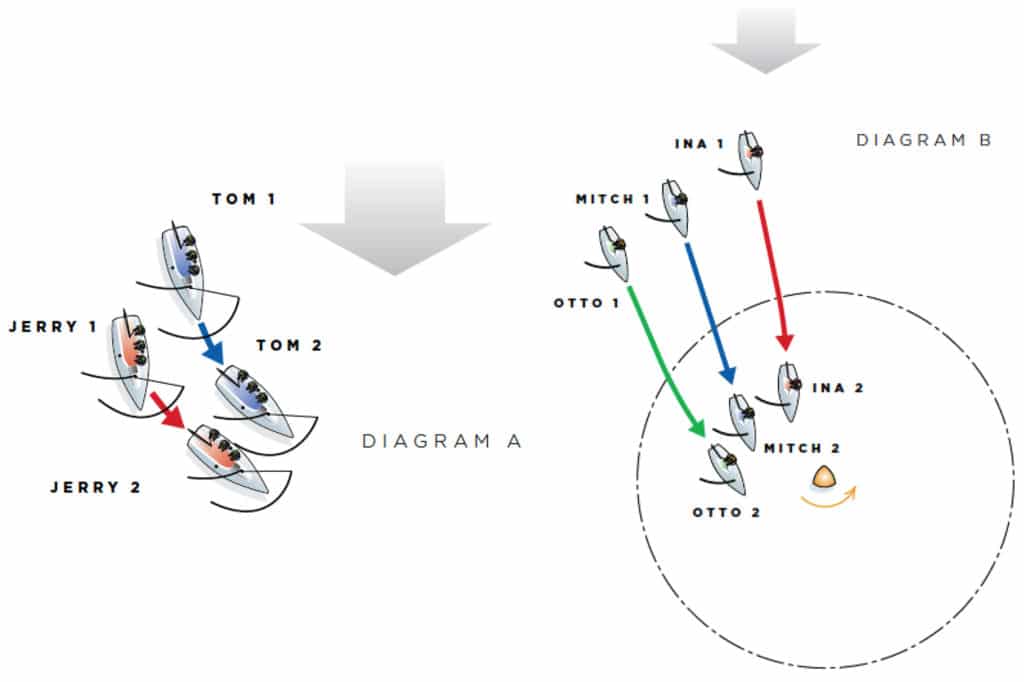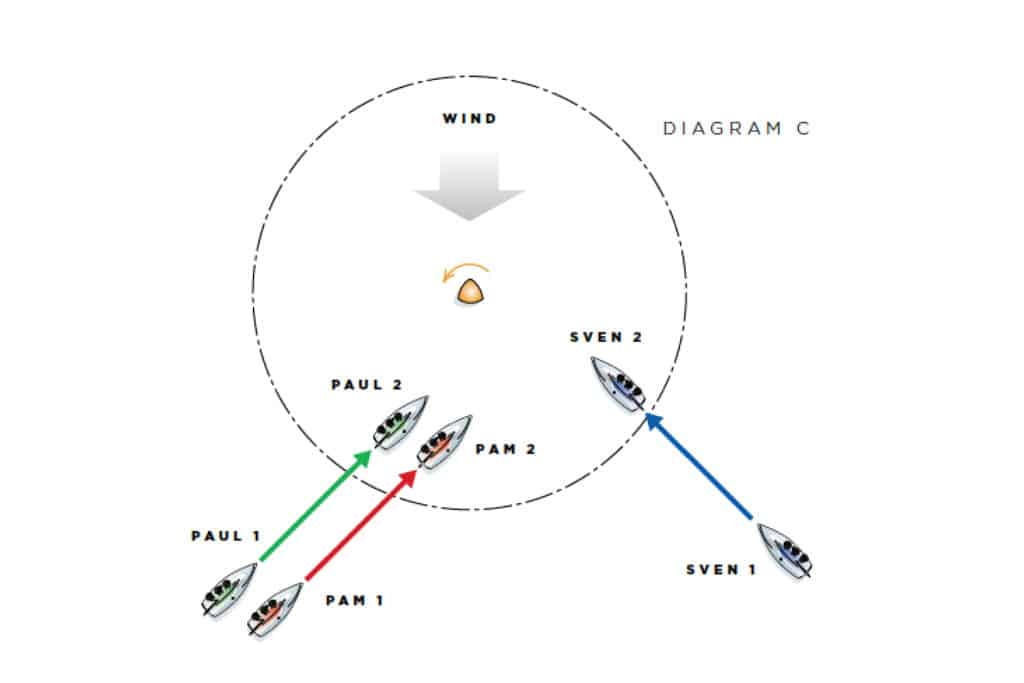
Every four years, on New Year’s Day of the year following the Olympic regatta, revised racing rules published by World Sailing take effect. This is the first of a series of articles covering important changes for 2017. I’ll start by discussing what’s new in Part 2, the rules that apply when boats meet. Most of the changes in the Part 2 rules are intended to simplify or clarify a rule and will not result in major game changes.
We start with two subtle changes that make Rule 21, Exoneration, easier to remember and fairer in many common situations. The rule was moved from Section C, “At Marks and Obstructions,” to Section D, “Other Rules,” and the words “under a rule of Section C” were deleted from it.
New Rule 21: EXONERATION
When a boat is sailing within the room or mark-room to which she is entitled, she shall be exonerated if, in an incident with a boat required to give her that room or mark-room, (a) she breaks a rule of Section A, rule 15 or rule 16, or (b) she is compelled to break rule 31.
Revised Rule 21 will apply whenever a boat is “sailing within the room or mark-room to which she is entitled.” In the 2013-2016 edition of the rulebook, Rule 21 applies only if the rule entitling a boat to room or mark-room is a rule of Section C. Two rules require a boat to give another boat mark-room: Rule 18.2 and Rule 18.3, both in Section C. Four rules require a boat to give another boat room: Rule 19.2(b) and Rule 20.2(c) in Section C, and Rule 15 and Rule 16.1 in Section B. The new rule is easier to remember because you enjoy the rule’s protection when any rule entitles you to room or mark-room, regardless of where that rule is located in the rulebook.
To see why the revised Rule 21 is a fairer rule, consider the common situation shown in Diagram A, which shows Tom and Jerry sailing on a run, spinnakers set. Tom overtook Jerry from clear astern, so Jerry may sail above his proper course (see Rule 17). Jerry luffs Tom so rapidly that even though Tom responds promptly and does all he can in a seamanlike way to avoid contact, Tom’s spinnaker touches Jerry’s windward shroud at Position 2. There’s no damage, and neither boat takes a penalty. Tom protests, alleging that Jerry’s rapid luff broke Rule 16.1 by not giving him room to keep clear.
The protest committee decides that Jerry broke Rule 16.1 as Tom claimed, but it also finds that Tom broke Rule 11 by failing to keep clear. Under the old rules, Tom can be exonerated only if Jerry’s breach of Rule 16.1 “compelled” Tom to break Rule 11 (see Rule 64.1(a)). Tom was not compelled to break Rule 11, because he could have luffed immediately and harder even though such a response would have risked broaching and would not have been seamanlike.
Under the old rules, Tom would be disqualified for breaking Rule 11, but under revised Rule 21, Tom would be exonerated because, while responding promptly in a seamanlike way to Jerry’s luff, Tom was “sailing within the room to which he was entitled.” To me, revised Rule 21 is fairer because it treats situations like this, which can arise when a boat fails to give room as required by Rule 15 or 16.1, in the same way that we treat a failure to give room or mark-room under a rule of Section C.

19.1 When Rule 19 Applies
Rule 19 applies between two boats at an obstruction except…(b) when rule 18 applies between the boats and the obstruction is another boat overlapped with each of them.
Rule 19.1(b) is a new rule for 2017. Since 2009, there have been two separate and different rules for passing marks and obstructions: Rule 18 for marks and Rule 19 for obstructions. Those two rules worked well for about five years, but in 2014, competitors and judges began to notice and publicize a problem that occurred when both Rule 18 and Rule 19 applied at the same time. The simultaneous application of these two rules unnecessarily complicates many mark-rounding incidents. I was surprised that despite all the close scrutiny the Part 2 rules receive, it took the sailing world (myself included) five years to discover this problem.
To understand the problem, we need to study how the rules apply to the incident shown in Diagram B. In light wind, three Lasers are overlapped on port tack, approaching a leeward mark to be left to port. Otto is on the outside, Mitch is in the middle, and Ina has the inside position. Between 2009 and 2014, this simple incident has occurred thousands of times in fleets all over the world, and Rule 18 has been used to guide all those boats around the leeward mark in a fair and orderly way.
We had been applying Rule 18.2(b)’s first sentence to the incident, and we had overlooked the fact that Rule 19.2 also applied at Position 2. Rule 18.2(b) requires Otto to give both Mitch and Ina mark-room. However, Otto is an obstruction to both Mitch and Ina because he holds the right of way over each of them under Rule 11. At Position 2, Rule 19.2(b) also applies. It requires Ina to give Mitch room to pass between her and Otto.
So you can understand the need for the new Rule 19.1(b), assume that at Position 2, it becomes clear to Mitch and Ina that if Otto continues on his current course, he will not give Mitch and Ina enough space for both of them to round the mark without contact occurring between them or between Ina and the mark. At that moment, Mitch and Ina are sailing within the mark-room they’re entitled to under Rule 18.2(b). If Ina holds her course, she will hit either Mitch or the mark. In so doing, she will break either Rule 11 or Rule 31. Ina will also break Rule 19.2(b) by not giving Mitch room to pass between her and Otto. Rule 21 will exonerate Ina if she breaks either Rule 11 or Rule 31, but not if she breaks Rule 19.2(b). Ina could avoid breaking Rule 19.2(b) if she luffed up and passed the mark on the wrong side.
Rule 19.2(b) is not required, nor was it ever intended, to apply in this situation. It only complicates the analysis. Because Rule 18 applies and Otto (the obstruction) is a boat overlapped with both Mitch and Ina, new Rule 19.1(b) will “switch off” Rule 19.2(b), leaving only Rule 18.2 to handle the rounding. If Ina makes contact with either Mitch or the mark as she rounds the mark, she will be exonerated under Rule 21.
There is, however, one scenario in which Rule 18 applies but Rule 19.2(b) is needed. It is shown in Diagram C, where Paul and Pam are overlapped on port tack, approaching Sven on starboard. Sven has the right of way over both Paul and Pam under Rule 10, and therefore Sven is an obstruction to both of them. If Pam elects to pass astern of Sven, both the current rules and the new rules require Pam to give room to Paul so he too can pass astern of Sven. The wording for Rule 19.1(b) was chosen carefully so Rule 19.2(b) applies in this scenario. Rule 19.1(b) does not “switch off” Rule 19.2(b) because Sven (the obstruction) is not overlapped with either Pam or Paul (see the definition Obstruction).
The bottom line is this: If you, like almost everyone else, had not noticed the problem Rule 19.2(b) causes in the situation involving Otto, Mitch and Ina, know that new Rule 19.1(b) will allow you to continue rounding leeward marks just as you have been doing since 2009. Just keep doing what you have been doing, and all will be well.
Email for Dick Rose may be sent to rules@sailingworld.com.









